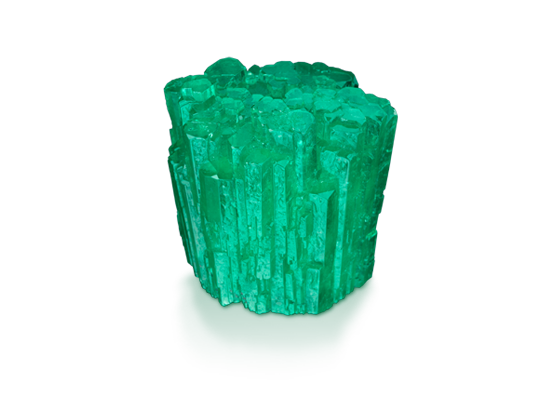
Pantone's color of the year for 2013, "Emerald" is an icon of luxury and elegance.
Since antiquity, emerald's bewitching lush green beauty has ignited people's passions. The first known emeralds were mined in Egypt before 330 BC. A favorite gemstone of Cleopatra, its name was derived from the ancient Greek word for green: "smaragdus." The soft green color of emeralds was nature's remedy for restoring eye function - looking at emeralds was thought to comfort the eyes and remove weariness and lassitude. Even today, the color green is associated with relieving stress and eye strain.
Emerald developed into the birthstone for May because its rich green color symbolizes spring's rebirth and renewal. Emerald is also the gemstone for twentieth and thirty-fifth wedding anniversaries.
Today, emeralds are mined mostly in Colombia, Zambia, Brazil, and Zimbabwe. Afganistan, Pakistan, and Russia are also emerald-producing countries. The emerald gemstone is the most famous member of the beryl mineral family (the aquamarine gemstone is also a member of the beryl mineral family). The emerald crystal typically forms in a six-sided prism, so it is naturally suited for the "emerald cut" in jewelry.

The varying presence of chromium, vanadium and iron elements in the crystal structure determine each emerald stone's natural color. Iron gives the stone a bluish tint, while chromium and vanadium yield a more intense green color. The most valuable emeralds are bluish-green to green with medium to medium-dark tone. Fine Colombian emeralds are highly regarded for their excellent color.
Zambian emeralds tend to have good clarity. However, it is rare for an emerald to have high clarity. Most emeralds are not "eye-clean" stones - they have inclusions and surface blemishes that you can readily see with the unaided eye. Sometimes, these inclusions and blemishes can be striking - designers use very included emeralds to enhance their expressive creations, and jewelers refer to included emeralds with pleasing organic and charming shapes as "jardin," French for garden.
Like color, clarity greatly affects the per carat price of emerald as a gemstone. Very low quality opaque stones can sell for as little as $10 per carat, whereas an exceptionally clean stone can sell for $50,000 per carat. Famous emeralds can yield extremely high prices. In 2011, bidding set a record $280,000 per carat for Elizabeth Taylor's emerald pendant.
Since high quality mined emeralds are expensive, more affordable alternatives for May birthstones are lab-grown emeralds, lab-created green cubic zirconia, and natural gemstones such as demantoid or tsavarite garnet, diopside, jadeite, green sapphire, and green zircon, to name just a few.
Although emeralds have 7.5-8 hardness rating on the Moh's Scale, they have only poor to good hardness. Emeralds are brittle, and therefore, can be damaged. Care should be taken when wearing, cleaning, storing and repairing all emerald jewelry.
Also, most emeralds in the marketplace are treated to enhance the green color (intensify color and improve color uniformity) and to improve clarity by hiding internal fractures. The most common routine emerald treatment is "fracture filling" - the process of filling an emerald's surface reaching fractures with either a green-dyed oil or resin ("dyeing") or colorless oil or resin (called "oiling" in the trade). Fracture filling is not permanent. Over time, treated emeralds can lose color, clarity and luster by instability of its filling material. The oils can dry out or be negatively altered in appearance by intense light.
Also, chemicals can damage emeralds so emerald jewelry should not be worn during house cleaning and care must be used when cleaning emerald jewelry. Emeralds should be cleaned with only warm water and mild soap - use a soft clean cloth and when necessary a very soft toothbrush, but avoid vigorous brushing. Never steam clean and never ultrasonic clean emerald jewelry.
Finally, heat can cause an emerald to fracture, so great care must be used by jewelry professionals when cleaning and repairing emerald jewelry.
 Comment below to Perlina- ask any question or comment
Comment below to Perlina- ask any question or comment
